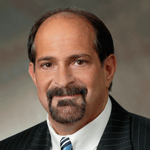
President & CEO
Company: On Assignment
Location: Calabasas, CA
Career Advice: “You need to distinguish yourself. But remember, we never get our reputations back. You don’t need to step on other people to get where you want to be.”
What is On Assignment’s critical differentiator, and how will you use that moving forward?
Peter Dameris: We know who we are. We know our strengths and weaknesses, and we exercise this knowledge every day. We’re not a bulk seller of human capital; we focus on science, technology, engineering, and mathematics [STEM] fields. We work with those we know and trust and are willing to have an ongoing conversation about emerging technology and how it shapes our focus.
What major issues do you have to consider when making decisions about your company’s future?
Dameris: There is a supply and demand problem in the fields we work with. We deal with skilled professionals, those with four-year degrees working in STEM fields. There is great demand for these specialists, but the supply is low. You can find work in these fields if you want to work, but for us the challenge is identifying adequate, qualified candidates. In tech, there’s constantly a cycle of development and destruction. Specific tech cycles aren’t something you can plan for, but you have to be aware of the constant evolution and understand the changing environment in order to be successful as you move forward.
What are the most important factors to consider when crafting a five-year strategy plan?
Dameris: You have to substantiate what is still viable. The contingent workforce is only going to increase because of things like Obamacare and the uncertain nature of the economy, so you have to look at what’s currently going on and where things are moving to figure out what to take with you moving forward and what to leave behind. You need to understand the end market and the direction of the economy. Strategy planning is about assessing the market against your internal capabilities and developing a plan to meet the needs of that market.
What does On Assignment’s executive team bring to the table when it comes to mapping out the company’s next five years?
Dameris: Everyone has different life and work experiences, different points of view, and different industries that they focus on; we rely on that, but our general process is quite different than some. We’re not going to pay an outside company a large fee to build us a strategy, put it in a three-ring binder, and hand it over for us to execute. Our process is much more collaborative. There’s a period where we consult with our clients for a real-world perspective on what’s affecting them. There’s a period for data gathering, analysis, for mapping out the strategies—and it’s important to understand that this is all done on a divisional basis. We have health care, physician, scientific, IT, and engineering staffing, all of which require different considerations and an entirely different set of theoretical alternatives.
How do you ensure such planning stays efficient and effective?
Dameris: The time for each process and division varies. There are a lot of hard conversations we have to have about where we are now and how we get to where we want to be. There’s a lot of debate, a lot of talking—we’ll have 10 meetings over the course of nine months to pour over the information and talk about it. We don’t present our strategy to the board until we are all in agreement.
Is there added pressure when you make this information public?
Dameris: It holds us accountable internally and publicly. If you’re a division president and you present your findings to the board, the board will hold you responsible. When we make this information available to the public, it widens the scope of that accountability.
What are your plans to implement this strategy effectively?
Dameris: There are no assurances, but that is why we spend so much time on the process and the plans for execution. We do our best to make a realistic, logical plan, and we’ll do our best to meet it.

